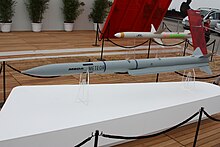
Back صاروخ جو-جو Arabic Hava-hava raketi Azerbaijani Ракета въздух-въздух Bulgarian Míssil aire-aire Catalan Rakety vzduch–vzduch Czech Luft-Luft-Rakete German Πύραυλος αέρος-αέρος Greek Misil aire-aire Spanish Õhk-õhk-rakett Estonian موشک هوابههوا Persian



An air-to-air missile (AAM) is a missile fired from an aircraft for the purpose of destroying another aircraft (including unmanned aircraft such as cruise missiles). AAMs are typically powered by one or more rocket motors, usually solid fueled but sometimes liquid fueled. Ramjet engines, as used on the Meteor, are emerging as propulsion that will enable future medium- to long-range missiles to maintain higher average speed across their engagement envelope.
Air-to-air missiles are broadly put in two groups. Those designed to engage opposing aircraft at ranges of around 30 km[1][2] to 40 km[3][2] maximum are known as short-range or "within visual range" missiles (SRAAMs or WVRAAMs) and are sometimes called "dogfight" missiles because they are designed to optimize their agility rather than range.[1][3] Most use infrared guidance and are called heat-seeking missiles. In contrast, medium- or long-range missiles (MRAAMs or LRAAMs), which both fall under the category of beyond-visual-range missiles (BVRAAMs), tend to rely upon radar guidance, of which there are many forms. Some modern ones use inertial guidance and/or "mid-course updates" to get the missile close enough to use an active homing sensor. The concepts of air-to-air missiles and surface-to-air missiles are closely related, and in some cases versions of the same weapon may be used for both roles, such as the ASRAAM and Sea Ceptor.